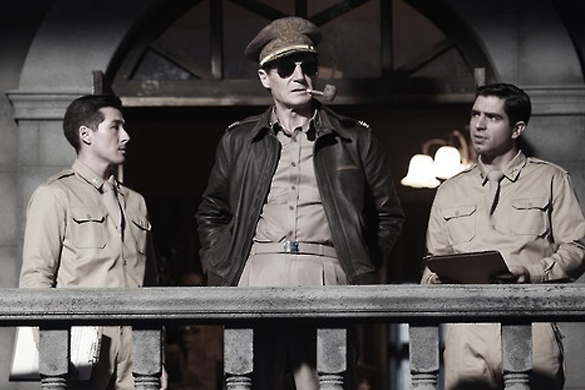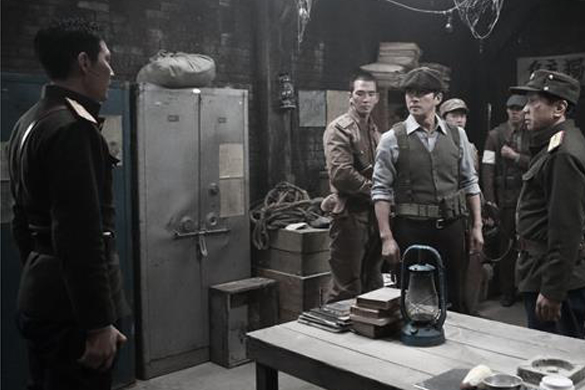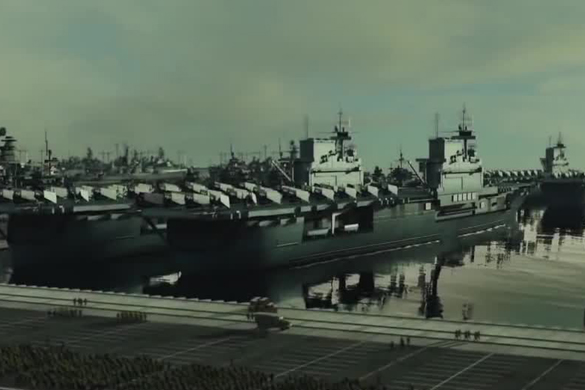
 |
||||
As the Korean War rages on with Northern troops surging forward to take and occupy ever-greater territory in Korea, US General Douglas MacArthur (Liam Neeson) – head of United Nations Command – sends eight elite South Korean soldiers on a covert assignment far behind enemy lines. Led by Navy Lieutenant Jang Hak-soo (Lee Jung-jae), this ‘X-Ray’ intelligence unit’s mission is to infiltrate North Korean headquarters, sabotage the North’s battle plans and clear the way for a US/South Korean naval incursion of Incheon, code-named Operation Chromite, in the hope it will turn the tide of the war once and for all.
Review: As Battle for Incheon: Operation Chromite is based on true events, the film begins with a series of pictorial representations of key players involved in Operation Chromite campaign and the lead-up to it, some – such as US President Harry S. Truman – being real life historical images while others - Douglas MacArthur, Jang Hak-soo, etc. - are shown as depicted in the film. Accompanying these images are brief written explanations the progress of the war that specifically led to Operation Chromite and these visuals and text combined give a succinct and wholly relevant overview of the forces at play in a far more natural way than could be achieved by clunky narration that has appeared much too readily at the start of numerous films, recent or not, regardless of whether you consider Korean films specifically or indeed Western movies.
Predictable though that may be and is, especially considering the fact that the outcome of the battle side of proceedings will already be known to anyone with even a vague knowledge of the historical event, it does work fairly well as a plotline running parallel to X-Ray Unit’s actual spy mission. However, virtually no time is given to character depth – both men standing more as caricatures than fully fleshed out individuals especially in the case of Northern commander Lee Gye-jin who is depicted as an almost cartoonish ‘evil personified’ character set against Jang Hak-soo’s ever moral, right-on-his-side hero. While that is kind of understandable since this is the story of the selfless sacrifice of eight incredibly brave men for their country, it does come across as somewhat pushed. Cinematically, Operation Chromite is for the large part a beautiful looking film with director John H Lee excelling to the greatest degree in the many chase/fight/shootout scenes. That said, the CGI used in the incursion scenes in the latter stages of the film is very noticeably CGI and the less than perfect rendering is rather a shame in what should have been the most breath-taking and explosive section of the story. John H Lee also attempts to add extra emotion into a number of scenes: During a shootout, one scene goes into slow motion while the sound of gunfire fades to be replaced by soaring, emotive music; or the introduction of a young, beautiful female character who becomes almost a love interest for Jang Hak-soo (the one character introduction I wish had been extended further), complete with melodramatic arc; etc.While none of these particularly brought a tear to my eye, I didn’t necessarily have a problem with the majority, except one... a character goes to where his mother lives but leaves before she realises he’s watching her and later, as he lies dying, he speaks to her by narration (the very narration I mentioned earlier) – even though she isn’t there – saying that alive or dead he’ll always be at her side. Forced, contrived and to my mind totally unnecessary.
The vast majority of the cast performances in Operation Chromite are perfectly fine, even accomplished, and not deserving of any particular criticism. However, the one role that to my mind leaves a lot to be desired is that of Liam Neeson as General MacArthur. Anyone who has watched Neeson in any number of his American movies, good or bad, will likely be fully aware of his inability to give a decent, believable American accent and certainly, from a personal point of view, the fact that he and I both originally hail from Northern Ireland means I can’t help but hear his Ballymena brogue screaming out of whatever accent he is attempting.
BATTLE FOR INCHEON: OPERATION CHROMITE (인천상륙작전) / 2016 / Directed by John H Lee
|
||||
All images © CJ Entertainment Review © Paul Quinn |
||||



